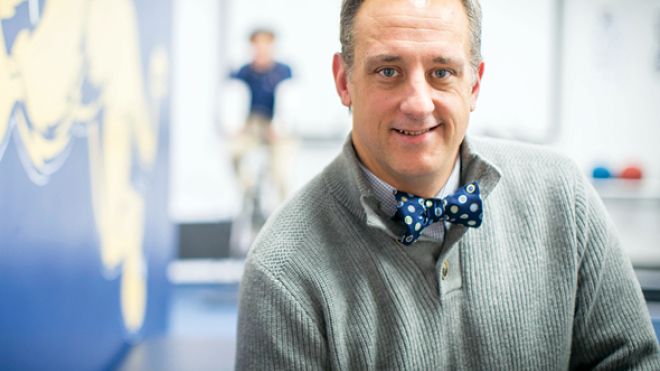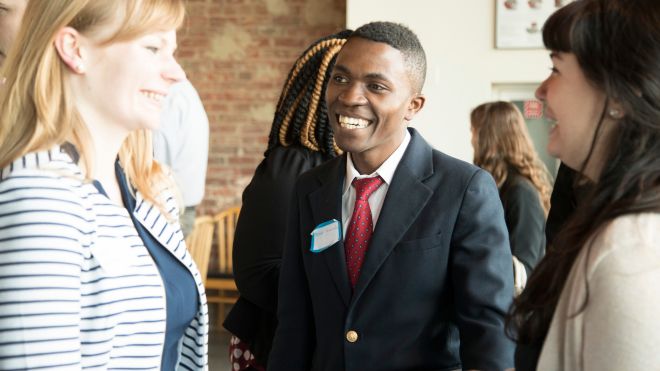Cory Conacher ’11 scored his first National Hockey League (NHL) goal in his debut game in January 2013. It was a moment he will never forget.
“It was so exciting to have so many of my family and friends at that game and to share that milestone with them,” says Conacher, who is the first former Canisius ice hockey player to appear in an NHL game and the First Atlantic Association Player to score an NHL goal. Conacher played for the Tampa Bay Lightning at the time, but was traded to the Ottawa Senators in early April.
Most hockey fans watched the slick two-on-one play as Tampa Bay Lightning forward Teddy Purcell fed Conacher the pass that enabled him to beat Washington Capitals goaltender Braden Holtby up high.
Cory’s parents, Dave and Debbie Conacher, however, saw their own personal miracle on ice.
“We probably over-celebrated,” recalls Dave Conacher. “My family ran over and we jumped up and down and hugged each other. It was crazy. We almost lost our balance and fell to the lower level because we were so caught up in the moment.”
You can’t blame the Conachers for getting emotional. The skill, talent and perseverance necessary to be a professional athlete are so rare that a select few actually make it. Factor in the obstacles that Cory Conacher overcame to make the NHL, and it’s as if he’s already conquered Mount Everest several times over.
A native of Burlington, Ontario, Conacher, 23, was born with bladder exstrophy, a rare defect in which the bladder is outside of the body. When he was just five days old, doctors performed a 10-hour operation to reconstruct Conacher’s pelvis and place the bladder inside of his body. He spent 10 weeks in traction as a newborn. He endured subsequent surgeries followed by traction at ages three, five and seven. But the surgery at age three had an unexpected side effect.
“Cory forgot how to walk,” recalls Debbie Conacher. “They never told us this could happen. I freaked out. I cried myself to sleep.”
Doctors assured the Conachers that Cory would be fine. His muscles atrophied due to the traction. However it took months for Conacher to regain his strength and walk again. By seven his parents say Conacher thrived. He played hockey and zoomed around the house on his roller blades. But at eight something went seriously wrong.
“I had no idea what was going on,” says Conacher. “I just knew I was really thirsty and got up several times during the night to get a drink of water.”
Doctors diagnosed Conacher with Type I diabetes. He learned to test his own blood sugar and gives himself insulin shots several times a day on his own. Today, when he is not playing hockey, he uses an insulin pump about the size of an MP3 player to monitor his blood sugar levels.
“It’s all about getting enough sleep and making sure I eat when I am supposed to in order to keep my blood sugar at the proper levels, especially on game days,” adds Conacher.
If his levels get too low, Conacher could slip into a diabetic coma, which can be fatal if left untreated.
“Cory has been found unconscious several times when away from home,” says Dave Conacher. “The paramedics stayed on the phone with me while they worked on him. It was very scary for us.”
Keeping their 17-year old son healthy was the Conachers' primary focus when they chose Canisius University – just a little more than an hour drive from their home across the border in Burlington, Ontario.
The fact that he had the opportunity to play hockey was just a bonus.
“We never directed Cory. It was never about him playing in the NHL or anything like that,” says Dave Conacher. “We wanted him to take care of himself, deal with his diabetes properly and play hockey because he loves the game. I think that is why he excelled.”
Unlike many of his Burlington Cougars (Junior A) teammates, Conacher was not drafted into the Ontario Hockey League (OHL). Conacher was likely passed over because of his size (5’ 8”, 180 pounds). It’s something he has battled his entire career. At 14, Conacher was cut from the Burlington Eagles Minor Bantam AAA team. The Eagles’ coach sent him down to the AA team because he was too small and the coach had concerns about Conacher being diabetic.
Rather than discourage Conacher, it fueled him.
“I don’t have bad feelings for that coach, but ever since then, I am motivated to prove people wrong,” says Conacher. “Your size doesn’t matter. As long as you have that grit and fearlessness on the ice, you can play through it.”
And while others may have noticed Conacher’s shortcomings Canisius Head Ice Hockey Coach Dave Smith spotted his talent and potential.
“We recruited Cory to Canisius because we saw speed, skill and competiveness,” says Smith. “We saw a need for our hockey team and Cory provided the answer.”
Debbie and Dave Conacher entrusted Smith to keep close tabs on their diabetic son who had battled so hard to get to this level. Their instincts proved to be right. Conacher thrived under Smith’s tutelage.
At Canisius, Conacher became the school’s all-time leader in points (147), goals (62), assists (85) and game winning-goals (12) in 129 games. That’s despite missing the first half of his freshman year with a broken arm. In 2009-10, he was named the Atlantic Hockey Association Player of the Year and a first-team All-Atlantic Hockey honoree. In 2010-2011, Conacher was named a second-team All-Atlantic Hockey Honoree and a First Team Lowe’s Senior CLASS All-America Award winner. Most recently, in April 2013, he was named to the All-Atlantic Hockey 10th Anniversary first team.
But perhaps more influential than any award, he is described as the spark who inspired his teammates.
“Cory made me a better player. I knew if he had the puck on his stick something great was going to happen,” says forward Vincent J. Scarcella ’11, who played on the same line with Conacher for three and half years and who now plays for the Kallinge/Ronneby IF (Division 1 hockey) for the Swedish League. “Cory brings an incredible amount of energy and emotion to the game. He was the heart and soul of the team.”
Conacher says that in Coach Smith’s program he developed as a player and worked on his defensive play, which is extremely important in the NHL. But he says he learned just as much off the ice.
“I really enjoyed the community service projects we did, whether it was Meals on Wheels or Habitat for Humanity,” says Conacher, who plans to run a camp for children with diabetes this summer. “It’s so important in the NHL to interact with fans and give back to the community.”
The management major also volunteered locally with Hasek’s Heroes, the Juvenile Diabetes Foundation and as a coach for Buffalo Shamrock’s Hockey.
“I want our players to have a balance of high-level of academics, high-level of hockey, and high-level of what I call social commitment,” says Smith. “For a young athlete like Cory to pass along such positive values is so valuable.”
But did Smith see NHL potential in Conacher and work to draw it out?
“One of my favorite quotes is, ‘The teacher will appear when the student is ready.’ Cory was always ready,” says Smith. “We challenged him to use his hockey gifts, to shoot the puck more and to play faster. Cory Conacher is solely responsible for his own success.”
Despite Conacher’s accolades and stellar performance at Canisius, no NHL team drafted him. He finished out the 2010-2011 season with brief stints with the Rochester Americans American Hockey League (AHL) team, the Cincinnati Cyclones of the East Coast Hockey League (ECHL) and the Milwaukee Admirals (AHL).
Then in July 2011, Conacher was offered a one-way contract with the Tampa Bay Lightning to play for their AHL affiliate (the Norfolk Admirals).
“Cory was so excited. He finally had the chance to prove himself,” says Dave Conacher. “He said, ‘Who cares where it is, or how much money it is. I have one year to show them what I can do.’”
Conacher wasted no time. In 2011-2012, he led the Norfolk Admirals to the Calder Cup Championship. He had 80 points in 75 games, was named AHL Rookie of the Year and won the Les Cunningham Award as the league’s Most Valuable Player. He is first player in AHL history to win all three in one year.
It was also in Norfolk where he also earned the nickname “Honey Badger” for being small but fierce -- and willing go into the “dirty areas” around the net in order to get the goal.
“The trainer in Norfolk showed us a YouTube video of the honey badger, a ferocious weasel-like animal. The commentator says, ‘the honey badger takes what he wants. He does what he wants,” says Conacher. “On the ice, I play the corners and go in front of the net. I take the heat. I try to do the things that help the team win.”
Conacher’s relentless efforts didn’t go unnoticed. Halfway through the 2011-2012 AHL season, he was signed to a one-year, two-way contract with the Tampa Bay Lightning, which meant he could play for either the AHL or NHL team. After starting the 2012-2013 season with the AHL’s Syracuse Crunch, he was invited to the Lightning’s abbreviated training camp (due to the NHL lockout). It was long enough for Conacher to make his mark – and achieve his dream of playing in the NHL.
“It was so incredible to be in the same room with guys like Vinny LaCavalier and Martin St. Louis,” says Conacher. “St. Louis is someone I have idolized my whole life.”
Lightning forward St. Louis, 37, is of similar stature (5’ 8’’, 180 lbs) to Conacher. He served as a mentor to Cory on the ice.
“Marty helped to calm me down during the games and he gave me little pointers,” adds Conacher. “It’s important for a young player to have someone throughout the game to keep you confident.”
The admiration is mutual.
“I love his game. I love his energy,” St. Louis told the Tampa Bay Times regarding Conacher. “’It’s not because he is small. People compare him to me and it’s not like I try to talk to him more because of that. Every guy that comes in here, if I see something, I want to help.”
As this issue goes to print, Conacher is the Senators' scoring leader and second in the NHL in rookie scoring. He is a leading candidate for the Calder Trophy (Rookie of the Year), which he believes is within reach if his team is successful. Like most NHL players, winning the Stanley Cup is also on Conacher’s to-do-list.
He is inspired to these lofty goals by some of his famous relatives.
Lionel, Charlie and Roy Conacher, cousins of Conacher’s great-grandfather — are each in the Hockey Hall of Fame. Lionel, also a champion in boxing, wrestling, football, baseball and lacrosse, was voted Canada’s top athlete of the first half of the 20th century.
“Cory sets his goals, and if he wants to win a Stanley Cup, and get to the Hockey Hall of Fame, and be with his relatives, we want that for him too,” say the Conachers, whose other children, Kelin, 25, and Jaclyn, 20 also play hockey. The youngest, 18 year-old Shane, will follow his brother’s footsteps. He will attend Canisius in the fall and play for the Ice Griffs.
The Conachers are beaming with pride given Cory’s recent success in the NHL. But they never lose focus of how tenuous his health can be.
“Our dream was always for Cory to live a normal life and be happy. Our dream is for a cure for diabetes. We’re sure that’s his dream as well. This is the one that matters most.”



